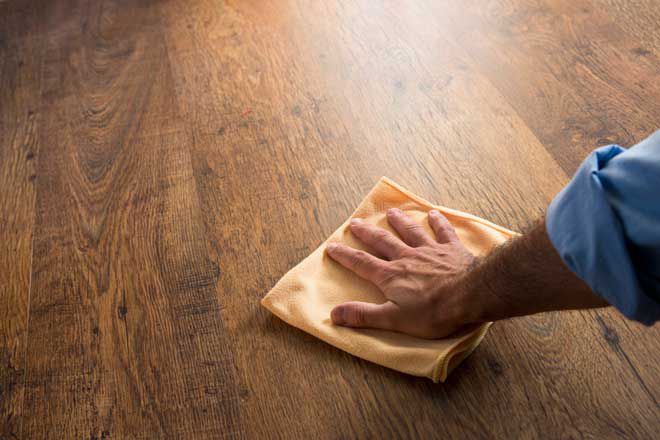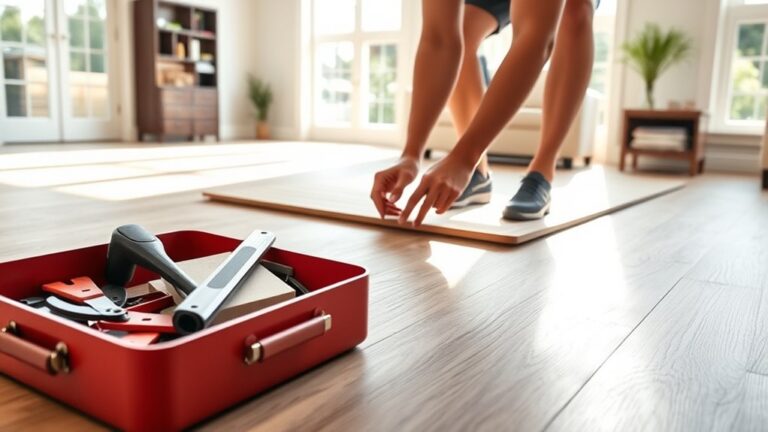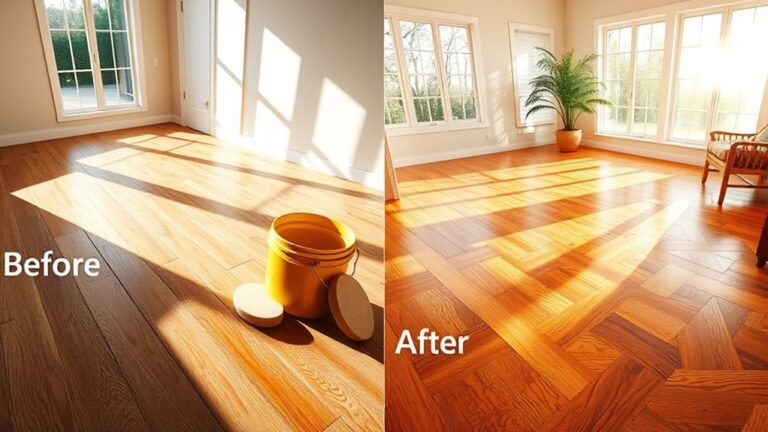Sandless floor refinishing is a process that involves the use of special products to clean, repair, and refinish hardwood floors without the need for sanding. The process typically starts with a thorough cleaning of the floor surface to remove dirt, grime, and any previous coating.
Next, a specially formulated cleaner is applied to remove any existing finish and repair minor scratches or imperfections. After that, a new topcoat is applied to protect and restore the floor’s beauty. This method is popular because it eliminates the dust and mess associated with traditional sanding and refinishing while still achieving a professional and long-lasting result.
It is suitable for both residential and commercial settings and can be done quickly and efficiently with minimal disruption.
What Is Sandless Floor Refinishing?
Sandless floor refinishing is a process used to restore the beauty and luster of hardwood floors without the need for sanding. It involves the application of a chemical solution that removes dirt, grime, and old finish from the surface of the floor. The solution is then buffed into the wood, filling in any scratches or imperfections and creating a smooth, uniform appearance.
This innovative refinishing method offers a number of benefits over traditional sanding and refinishing. It is quicker, less messy, and more cost-effective, making it an attractive option for homeowners who want to restore their floors without the hassle and expense of sanding. Additionally, sandless floor refinishing is environmentally friendly, as it produces less dust and waste compared to traditional methods.
Whether you have a small area or an entire home to refinish, sandless floor refinishing is a convenient and effective solution to restore the beauty of your hardwood floors.
Benefits Of Sandless Floor Refinishing
Sandless floor refinishing is a great alternative to traditional sanding methods, offering several important advantages. Firstly, it helps to save time and effort. Unlike sanding, which requires extensive prep work and cleanup, sandless floor refinishing can be completed quickly and with minimal disruption. Additionally, this method eliminates the need for sanding dust, which is a common concern for many homeowners. Not only does this make the process cleaner, but it also reduces the risk of respiratory issues for residents. Another key benefit of sandless floor refinishing is its cost-effectiveness. Since there is no need for expensive machinery or extensive labor, it can be a more affordable option for revitalizing your floors. Lastly, this technique preserves the original beauty of your floors, as it gently removes the surface layer without causing any damage.
Why Choose Sandless Floor Refinishing?
Considering refinishing your floors? Opting for sandless floor refinishing can be a smart choice, delivering outstanding results without the hassle of traditional methods. Here are a few reasons to choose this innovative approach:
| 1. | No sanding: Unlike traditional refinishing, there’s no need to sand the entire floor surface. Sandless refinishing utilizes chemical cleaners and abrasives to prepare the surface, saving time and avoiding the mess of sanding. |
| 2. | Quick and convenient: Sandless refinishing is a relatively fast process, usually taking just a day or two. There’s no need to vacate your home or deal with extended drying times. |
| 3. | Cost-effective: Traditional refinishing can be expensive due to labor costs, materials, and the need to remove furniture. Sandless refinishing eliminates these expenses, making it a more budget-friendly option. |
| 4. | Environmentally friendly: Sandless refinishing produces less dust, VOCs, and waste compared to traditional methods, making it a greener choice for your home. |
| 5. | Quality results: Despite skipping sanding, sandless techniques offer exceptional results. The process allows for deep cleaning, repairing scratches, and applying a new finish, leaving your floors looking beautiful and rejuvenated. |
With the simplicity, speed, and cost-effectiveness of sandless floor refinishing, it’s clear why many homeowners are opting for this method over traditional refinishing. Consider choosing this alternative to revitalize your floors without the hassle.
Assessment And Preparation
No matter the condition of your floor, sandless floor refinishing can help restore its beauty and durability without the need for sanding. The first step in the process is a thorough assessment of the floor condition. This involves inspecting for any deep scratches, stains, or uneven areas. Based on the assessment, the necessary repairs are identified.
Once the floor is assessed, the next step is to prepare the area for refinishing. This includes removing all furniture and rugs from the room. It is important to ensure that the floor is clean and free from any debris or dust. This can be achieved by sweeping and vacuuming the area.
After the area is prepared, a cleaning solution is applied to remove any residual dirt and grime. The solution is eco-friendly and safe for both the floor and the environment. It effectively breaks down any build-up and prepares the surface for the refinishing process.
Once the solution has been applied and allowed to sit for a short period, a specialized floor finish is applied. This finish is designed to penetrate the floor and create a protective layer that enhances its appearance and durability. The finish is available in a variety of colors and finishes to suit your personal style.
The final step in the process is allowing the floor to dry. This typically takes a few hours, depending on the temperature and humidity levels. Once dry, the floor is ready to be enjoyed, with no need to worry about sanding or extensive downtime.
Cleaning And Surface Preparation
When it comes to sandless floor refinishing, the first step is cleaning and preparing the floor surface. Specialized solutions and techniques are used to ensure that the floor is free from any dirt, grime, or previous coatings that may affect the refinishing process. The cleaning solution is applied to the floor, and it helps to dissolve any contaminants while being safe for the environment.
Once the floor is thoroughly cleaned, the next step is surface preparation. In order to achieve a smooth and even finish, any imperfections on the floor surface are addressed. This may include filling in cracks, repairing damaged areas, and sanding down rough spots. The objective is to create a clean and level surface that is ready for the refinishing process.
By using specialized cleaning solutions and techniques, sandless floor refinishing ensures that the floor surface is properly prepared. This allows the subsequent steps in the refinishing process to be carried out effectively, resulting in a beautifully restored and renewed floor without the need for sanding.

Layer Application
Layer application is a key component of the sandless floor refinishing process. This innovative technique involves applying specially formulated products to renew and rejuvenate the floor without the need for sanding. The first layer typically consists of a deep-cleaning solution that removes dirt, grime, and old finishes from the floor surface. This solution is carefully applied and worked into the floor using a mop or applicator. Once the cleaning solution has been allowed to penetrate and lift away dirt and residues, the next layer is applied.
The second layer often includes a bonding agent that helps the new finish adhere to the floor surface. This layer is applied and allowed to dry completely before the final layer is added. The final layer typically consists of a protective coating that adds shine and durability to the floor. Depending on the specific product being used, additional layers may be applied to achieve the desired level of gloss or protection.
The layer application process is designed to restore the beauty and functionality of hardwood, laminate, engineered wood, or vinyl floors, while avoiding the mess and inconvenience associated with traditional sanding and refinishing methods.
Finishing Touches
After the sanding and staining process is complete, protective coatings and final touches are applied to further enhance the durability and appearance of the floor. These coatings act as a barrier against scratches, stains, and everyday wear and tear, ensuring the longevity of the refinished floor. To apply these coatings, a high-quality sealant or polyurethane finish is used, which also adds a beautiful shine to the floor.
Before applying the protective coating, the floor is thoroughly cleaned to remove any dust and debris. This ensures a smooth and even application of the coating. The protective coating is then applied using a roller or brush, making sure to cover the entire floor surface.
Once the initial coating has dried, additional coats may be applied for added protection and a more polished look. It is important to allow each coat to dry completely before applying the next one. This process may take several hours or even days, depending on the type of coating being used.
After the final coat is applied, the refinished floor is left to cure for a designated period of time. This allows the protective coating to fully harden and bond with the wood, creating a durable and long-lasting finish. Once the curing process is complete, the floor is ready to be enjoyed, with its newly restored beauty and enhanced durability.
The Chemistry Behind Sandless Floor Refinishing
The Chemistry Behind Sandless Floor Refinishing
Sandless floor refinishing is a revolutionary process that uses advanced technology and innovative chemistry to restore the beauty and shine of hardwood floors. Traditional refinishing methods involve sanding down the entire surface of the floor, which can be messy, time-consuming, and inconvenient. However, with sandless refinishing, homeowners can skip the sanding step while still achieving exceptional results.
The science behind sandless floor refinishing involves the use of powerful cleaning agents and specialized coatings. First, the floor is thoroughly cleaned to remove any dirt, grime, or old finishes. This is typically done using a professional-grade cleaner that is carefully formulated to lift away dirt without damaging the wood.
Once the floor is clean, a bonding agent is applied to create a strong adhesion between the existing finish and the new topcoat. This bonding agent ensures that the new coating will adhere properly and provide long-lasting protection.
Finally, a durable topcoat is applied to the floor, sealing and protecting the wood while enhancing its natural beauty. This topcoat is specifically designed to dry quickly and provide a high level of durability, ensuring that the refinished floor will last for years to come.
The science and technology behind sandless floor refinishing have revolutionized the way homeowners can restore and maintain their hardwood floors. With this innovative process, it is now possible to achieve beautiful, like-new floors without the hassle and mess of traditional sanding.
Is Sandless Floor Refinishing Truly Sandless?
Sandless floor refinishing is indeed sandless, eliminating the need for traditional sanding and the messy dust that comes along with it. Instead, this innovative process utilizes a chemical solution to remove old finishes and restore the beauty of your floors without the hassle.
Sandless floor refinishing is often misunderstood due to its name. However, it does not involve traditional sanding methods. Let’s debunk some common myths and clarify the absence of traditional sanding.
Myth: Sandless floor refinishing doesn’t remove scratches or damages.
Contrary to belief, sandless floor refinishing can effectively remove scratches, damages, and imperfections. The process involves the use of specialized equipment and solutions that can restore the appearance of your floor without the need for sanding.
Myth: Sandless floor refinishing is not suitable for all types of floors.
Sandless floor refinishing is suitable for various types of floors, including hardwood, laminate, vinyl, and engineered wood. The process can be tailored to suit different floor materials, ensuring a quality and long-lasting result.
Myth: Sandless floor refinishing results in a subpar finish.
On the contrary, sandless floor refinishing can provide a high-quality finish that rivals traditional sanding methods. The process involves deep cleaning, repairing, and buffing the floor before applying a durable finish. With proper techniques and products, sandless refinishing can produce exceptional results.
| Benefits of Sandless Floor Refinishing: |
|---|
| • Avoids the mess and dust associated with traditional sanding |
| • Faster process with minimal downtime |
| • Cost-effective compared to full sanding and refinishing |
| • Environmentally friendly option as it reduces waste |
| • Extends the lifespan of your flooring |
If you’re considering refinishing your floors, sandless floor refinishing can be a viable and efficient option. It provides impressive results without the hassle and inconvenience of traditional sanding, making it a popular choice for homeowners.
How The Floor Appears Polished Without Sanding
When it comes to sandless floor refinishing, the process is remarkably effective. It involves uncovering the methods used to achieve a smooth and polished finish without the need for sanding. Instead of traditional sanding techniques, a sandless floor refinishing method utilizes unique solutions and technology to restore the original beauty of the floor surface.
The process starts with thorough cleaning of the floor to remove any dirt, grime, or debris. Next, a specially formulated solution is applied to the floor, which helps to breakdown any existing finish and prepares the surface for the next step. After that, a new finish is applied to the floor, deeply penetrating the wood to provide a long-lasting protection and a beautiful, polished appearance.
This innovative approach to floor refinishing not only saves time and money but also eliminates the hassle and mess typically associated with traditional sanding methods. It is a great option for those who want to refresh their floors without the need for extensive sanding and refinishing.
Choosing The Right Professional For The Job
When choosing a professional for sandless floor refinishing, there are several factors to consider. First and foremost, it’s important to research the service provider’s experience and reputation. Look for professionals who have a proven track record in the industry and positive customer reviews.
The next factor to consider is the quality of the products and techniques used by the service provider. Ensure that they use environmentally-friendly and non-toxic solutions, as well as state-of-the-art equipment.
Furthermore, it’s crucial to inquire about the timeline and cost of the refinishing project. Obtain multiple quotes from different professionals to compare prices and ensure a fair deal.
Lastly, don’t forget to ask for a guarantee or warranty on the service provided. A reputable professional will stand by their work and offer some form of assurance.
| Factors to consider when selecting a sandless floor refinishing service provider |
| Research the service provider’s experience and reputation |
| Confirm the use of quality, environmentally-friendly products and techniques |
| Compare quotes from multiple professionals |
| Inquire about guarantee or warranty on the service provided |
Preparing Your Space For Sandless Floor Refinishing
Preparing your space for sandless floor refinishing is an important step to ensure a successful and efficient process. Here are some tips and guidelines to help you get your home or business ready:
- Remove all furniture, rugs, and other items from the area that will be refinished.
- Clean the floor thoroughly to remove any dirt, dust, or debris.
- Mend any cracks or damages in the floor prior to refinishing.
- Close off the area being refinished to prevent any accidental foot traffic.
- Consider covering nearby surfaces, such as walls and cabinets, to protect them from any potential damage during the refinishing process.
- Ensure proper ventilation in the area to allow for optimal drying time.
- Follow any specific instructions provided by the sandless floor refinishing professional.
- Once the refinishing is complete, wait for the recommended drying time before allowing foot traffic.
- Regularly maintain and clean your newly refinished floor to extend its lifespan.
By following these tips and guidelines, you can prepare your space for sandless floor refinishing and achieve a beautiful, durable, and restored floor.
Maintaining And Caring For Your Refinished Floor
Proper maintenance and care are essential to ensure the longevity and appearance of your refinished floor. Here are some best practices to follow:
- Regular Cleaning: Sweep or vacuum your floor regularly to remove dirt and debris. Use a damp mop with a gentle cleaner specifically designed for hardwood floors, making sure not to saturate the floor.
- Avoid Scratches: Place felt pads under furniture to prevent scratches when moving items. Avoid wearing shoes with hard soles indoors and use floor mats at entryways to trap dirt.
- Keep it Dry: Wipe up spills immediately to prevent water damage. Avoid using excessive water or harsh chemicals when cleaning, as they can damage the finish.
- Minimize UV Exposure: Direct sunlight can fade the color of your floor. Use blinds, curtains, or UV-protective coatings on windows and doors to minimize exposure.
- Be Careful with Pets: Keep pet nails trimmed to prevent scratching. Place protective mats under food and water bowls to avoid spills.
- Regular Maintenance: Depending on the wear and tear, your refinished floor may need periodic maintenance such as recoating or refinishing. Consult with a professional to determine the appropriate timing.
Frequently Asked Questions Of How Does Sandless Floor Refinishing Work
How Does Sandless Floor Refinishing Work?
Sandless floor refinishing works by using a chemical cleaning solution and a specialized machine to remove dirt, grime, and imperfections from the floor’s surface. The solution is applied, allowed to penetrate the wood, and then the machine with abrasives is used to buff away the top layer.
Finally, a protective coating is applied to give the floor a fresh, renewed look.
What Are The Benefits Of Sandless Floor Refinishing?
Sandless floor refinishing offers many benefits, including no dust or mess, no need for sanding, and a quicker process compared to traditional refinishing methods. It also allows for spot repairs, as only the areas that need refinishing are addressed. Additionally, the use of a protective coating helps extend the lifespan of the floor and makes it easier to clean and maintain.
Is Sandless Floor Refinishing Suitable For All Types Of Floors?
Sandless floor refinishing is suitable for most types of floors, including hardwood, engineered wood, laminate, and some types of vinyl. However, it is always best to consult with a professional to determine if your specific type of flooring can be refinished using the sandless method.
Some floors with severe damage or deep scratches may still require traditional sanding and refinishing.
Conclusion
Sandless floor refinishing is a revolutionary technique that offers a hassle-free and cost-effective solution for restoring the beauty of your floors. With no sanding required, this method is not only time-efficient but also eco-friendly. By using advanced products and techniques, sandless floor refinishing eliminates the need for dust, odor, and inconvenience.
The result is a flawless, durable, and long-lasting finish that will breathe new life into your tired floors. Experience the benefits of sandless floor refinishing and give your floors the rejuvenation they deserve.




